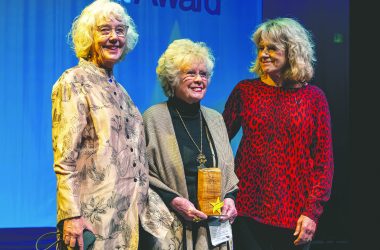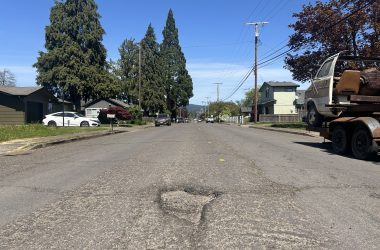 DANA MERRYDAY/PHOTO The Buster Keaton mural welcoming people to Historic Downtown Main Street in Cottage Grove needs repair.
DANA MERRYDAY/PHOTO The Buster Keaton mural welcoming people to Historic Downtown Main Street in Cottage Grove needs repair.
IF YOU GO:
What: Raffle for Buster Keaton mural renovation. Includes gift certificates for Lily of the Field Bed and Breakfast, Saginaw Winery, Rogers Antiques, Coast Fork Brewing, El Tapatio and more.
When: Winners drawn March 29 at KNND Radio
Why: Buster Keaton mural renovation
Tickets: one for $3; four for $10; and 10 for $20. Purchase at The Bookmine, Crafty Mercantile, or the Cottage Grove Historical Museum.
Donate: Cottage Grove Historical Society, P.O. Box 142, Cottage Grove.
More info: cghistory.org
Buster Keaton, silent film star, writer and director, made a lasting impact on Cottage Grove. On May 27, 1926, he rolled into town pulling 18 freight cars of cannons, covered wagons, old-timey rail cars and enough material to build an entire town – which they did, where Safeway is today.
Keaton’s family and many of his 65 crew members lived in what is now the Cottage Grove Hotel, formerly called the Hotel Bartell, after being drawn to the area by the Oregon Pacific & Eastern Railway, which was used extensively for two months during filming of the masterpiece, “The General.”
About $375,000 – half of the film’s budget – was spent in Cottage Grove, and 1,500 locals were hired as laborers, craftsmen and as extras.
Up to 4,000 curious onlookers watched the production crew dump a perfectly good locomotive into the Row River, along with a custom-built wooden trestle, which was set on fire and rigged with charges. It was a one take scene, and the most expensive of the silent film era. The river had to be dammed on Culp Creek to store enough water to give the desired effects.
The one thing Keaton requested of the assembled throng was: “Don’t cast a shadow in my light.”
Another effect Keaton had on Cottage Grove was more personal.
He was a keen baseball player and used baseball to unwind and help his crew relax and bond. He and his crew often challenged the local baseball team and all-comers to pickup games. When a player tripped in a hole on the field and was hurt, Keaton put up money to have it fixed. He didn’t act like a big shot, but rather was friendly and approachable. The town really loved and respected him.
Cottage Grove is a mecca for film history, especially for Keaton aficionados. You can still see the buttes that appear in “The General.” The Row River trail is built where the track laid on which Buster did his incredibly dangerous stunts – running along train car roofs, sitting on the engine’s moving coupling rods, or riding the cow-catcher while throwing one railroad tie to dislodge another, saving the train from derailing. There are several signs planned to mark these sites as part of the The Oregon Film Trail.
Before Covid, the Buster Keaton Days summer festival would bring many to town to tour the landmarks, watch restored films and steep in all things Keaton.The International Buster Keaton Society is scheduled to return this August, Covid-willing. A few summers ago, “The General” was played to a large, approving crowd in Bohemia Park with a newly written musical score performed live by an orchestral ensemble.
Keaton’s face stares down from the corner of Main & 99 – the scene of Keaton holding on for dear life to the train’s cow-catcher. Also portrayed is the trainwreck scene of “The Texas” plunging into the river through the flames. It may be the only public recognition of Buster Keaton in the country. The mural is painted on a building that was there in Keaton’s day, but which looked much different then. An old photo shows a wood framed peak-roofed structure, sporting a sign saying “Fred’s Place.” It’s standing right next to the Hotel Bartell where Buster and his people lived during the filming. The current building once housed The Hot Spot, a legendary cafe and social center for woodworkers.
Lane County Tax records state that the original building was built in 1920. It also records that its effective building date is 1975, after a major rebuild brought it up to code level. It was probably at this time that ceramic building tile was used to rebuild the east wall, which bears the mural. Its exterior surface has grooves to enable it to be covered with stucco or plaster. That was never done, leaving a very challenging surface to paint on, putting it mildly.
Howard Tharpe, a local artist, was a part of a loosely-organized mural committee, which had no real standing but nevertheless, they liked painting murals and did quite a few of them around town, including the Fred’s Place mural in 2002. The details are foggy on how it all came together, but Tarpe is known for working on the mural single handedly.
Tharpe had painting in his blood. His father was a commercial painter who specialized in billboards and sign painting. He was born in Los Angeles. where he was influenced by cinema. His expertise led him to work for George Lucas, Universal Studios, Obie Media and others. Tharpe got a taste for mural painting and is responsible for many murals in the Los Angeles area, as well as painting official signs for the 1984 Olympics held in L.A.
A visit to his cousin Suzanne Hueber-Sannes and her father, Richard Rickabaugh, here in Cottage Grove, coincided with his desire to leave the rat-race of film-world Los Angeles behind. He liked what he experienced here and moved his family to Cottage Grove. Tharpe soon went about putting his mark on his new town. Besides the Buster Mural, he collaborated with artist Connie Huston to paint the Opal Whiteley mural at All America City Square (2001), 4th of July Parade on the south wall of The Flower Basket (2005), and other murals as well.
Tharpe died after a fall in 2019. When his cousin Suzanne Huebner-Sannes heard rumblings of an effort to restore the mural, she had to get involved.
“I wanted to honor Howard’s memory and also our family’s connection to film which has always been very important to me. I want to help get his mural back looking vibrant and beautiful as a community asset,” she said.
Time has not been kind to Tharpe’s mural; the colors have faded and become grimy. In places the paint is peeling off the surface in large patches. It has given the mural a forlorn and even scary look to it. First-time visitors, not necessarily in the know about Keaton’s history with the Grove, are sometimes taken aback at his looming presence at the gateway to the Historic District.
The Historic Landmarks Commission administers matching grants aimed at historic building owners to help renew or restore their buildings facades, and has agreed to fund the restoration project, chair Lloyd Williams said.
A $4,000 grant was given to the Restore Buster Keaton Mural Committee, which is working to raise at least that in matching funds to pay for the materials, surface preparation, support for the artist, and other expenses. Murals can be done with volunteer labor and often capture a certain spirit.
But to get a stunning result on a mural, it takes a practiced, experienced hand. Artist Connie Huston has that in spades. You can see her work on 5 Flying Monkeys, Opal Park, Dougherty Pool Aqua Lions mural, and other examples around town. Huston will work to make the new mural more colorful, bright, and inviting by altering the perspective slightly and working to adjust details for historical accuracy, all while honoring Tharpe’s original concept and depiction.
Please join in the effort to help restore Buster Keaton to his 1926 best. In doing so you will also honor a hard-working volunteer muralist who left his mark on his adopted town. With the fresh paint, the refreshed mural will be a welcomed sight for both those who come looking for Keaton, and those who stumble upon him.
Email: [email protected]








